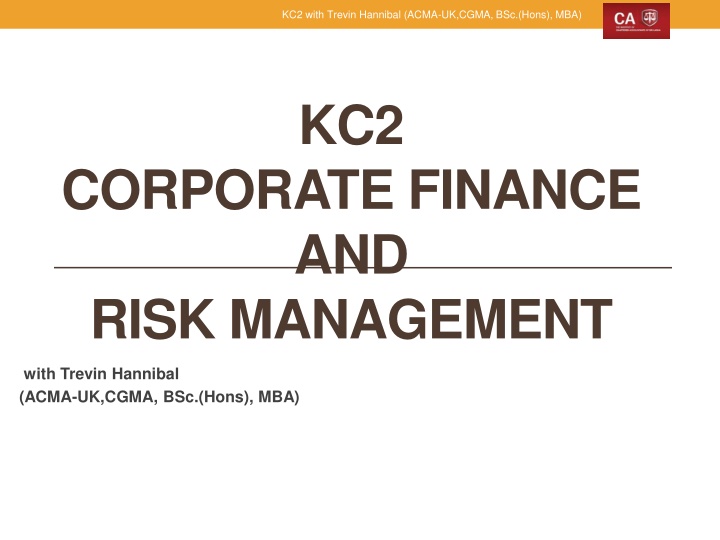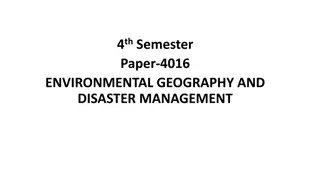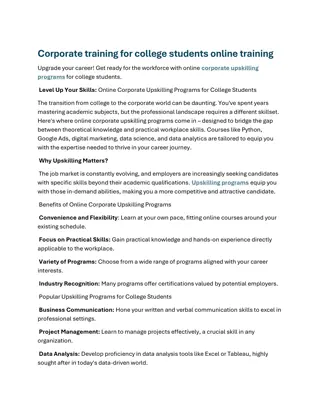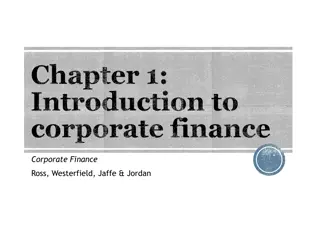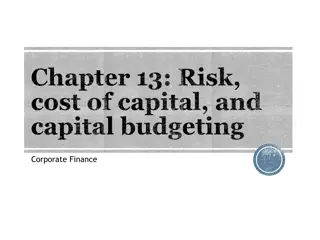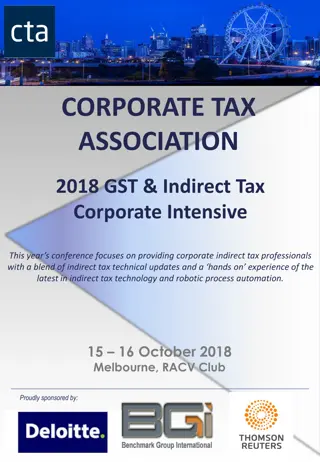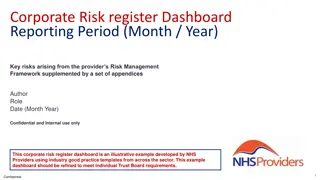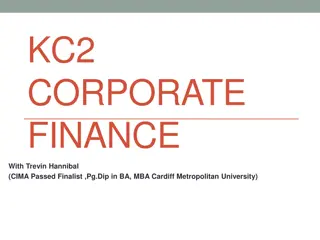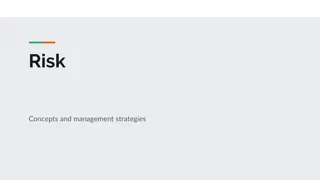Corporate Finance and Risk Management with Trevin Hannibal
Scheme of Work and Question topics related to Corporate Finance and Risk Management with Trevin Hannibal including shareholder wealth maximization, financial analysis, cash forecasting, leasing, capital structure, project appraisal, investment decisions, financial valuations, and risk management.
Download Presentation

Please find below an Image/Link to download the presentation.
The content on the website is provided AS IS for your information and personal use only. It may not be sold, licensed, or shared on other websites without obtaining consent from the author.If you encounter any issues during the download, it is possible that the publisher has removed the file from their server.
You are allowed to download the files provided on this website for personal or commercial use, subject to the condition that they are used lawfully. All files are the property of their respective owners.
The content on the website is provided AS IS for your information and personal use only. It may not be sold, licensed, or shared on other websites without obtaining consent from the author.
E N D
Presentation Transcript
KC2 with Trevin Hannibal (ACMA-UK,CGMA, BSc.(Hons), MBA) KC2 CORPORATE FINANCE AND RISK MANAGEMENT with Trevin Hannibal (ACMA-UK,CGMA, BSc.(Hons), MBA)
Trevin Hannibal (ACMA-UK,CGMA, BSc.(Hons), MBA) Scheme of Work Questions in the handout are linked to the following topics Shareholder wealth maximization Financial analysis Cash forecasting Leasing Capital structure Project appraisal/ Investment decisions Financial Valuations Financial Risk Management
KC2 with Trevin Hannibal (ACMA-UK,CGMA, BSc.(Hons), MBA) Introduction Finance
KC2 with Trevin Hannibal (ACMA-UK,CGMA, BSc.(Hons), MBA) Stakeholder objectives
KC2 with Trevin Hannibal (ACMA-UK,CGMA, BSc.(Hons), MBA) Role of the treasury department Banking Managing liquidity Funding Mitigating currency risk
KC2 with Trevin Hannibal (ACMA-UK,CGMA, BSc.(Hons), MBA) Question 1- Requirement a) Discuss the role of the treasury department when determining financing or refinancing strategies in the context of the economic environment described in the scenario Explain how these might impact on the determination of corporate objectives.
KC2 with Trevin Hannibal (ACMA-UK,CGMA, BSc.(Hons), MBA) Answer plan Introduction sentence - economic environment Inflation zero, fall in interest rate On financing a re-financing options to the treasury department What is the current situation at CD Can they increase debt ?if so the implications Can they increase equity? if so the implications Implications to the corporate objectives Can we re-finance? if so implications What will happen to share holders wealth
KC2 with Trevin Hannibal (ACMA-UK,CGMA, BSc.(Hons), MBA) Introduction The scenario in this question concerns a privately owned entity based in a holiday destination. Inflation is near zero and interest rates are expected to fall. The treasury department needs to decide how to deal with the challenges and opportunities the specific set of circumstances provide and evaluate the impact on the entity s capital structure
KC2 with Trevin Hannibal (ACMA-UK,CGMA, BSc.(Hons), MBA) Increase the debt Finance theory suggests that entities should use a certain amount of debt in their capital structure to lower the cost of capital. Debt is cheaper than equity because interest payments (usually) attract tax relief and expected returns are lower. This is because interest is (usually) secured and providers of debt do not participate in profits. Here we have a mixture of secured and unsecured debt, but the entity appears sound and of high credit worthiness so should be able to borrow at comparatively favourable rates
KC2 with Trevin Hannibal (ACMA-UK,CGMA, BSc.(Hons), MBA) Arguments against debt The opposite argument is that in a period of low and falling interest rates, fixed rate debt becomes a burden. Some of the reasons are as follows: The real value of debt is not being eroded when there is low or no inflation, so one of the benefits of debt disappears. If growth is expected to be modest, debt interest may have to be paid out of static (or even falling) profits, lowering returns to shareholders. Although nominal interest rates may fall, they never become negative, so the real cost of borrowing increases
KC2 with Trevin Hannibal (ACMA-UK,CGMA, BSc.(Hons), MBA) Raising equity Raising equity is safer if profits are falling as dividends do not have to be paid and the shareholders do not get their money back in a liquidation. However, raising new equity in a private entity is more difficult than in a public entity and this method of raising new capital raises many additional issues such as whether to plan for a public listing or a rights issue and how to value the shares
KC2 with Trevin Hannibal (ACMA-UK,CGMA, BSc.(Hons), MBA) Conclusion The main issue for the treasury department to decide is what combination of dividend policy and capital structure is likely to maximize the present value of cash flows to shareholders. This is where the financing strategies adopted contribute to the determination of the objectives of the entity
KC2 with Trevin Hannibal (ACMA-UK,CGMA, BSc.(Hons), MBA) Question 1- Requirement b) Evaluate the appropriateness of CD's current objective and of the two new objectives being considered. Discuss alternative objectives that might be appropriate for CD Conclude with a recommendation.
KC2 with Trevin Hannibal (ACMA-UK,CGMA, BSc.(Hons), MBA) Answer plan Evaluation of the current objective- increase divided Benefits of the current objective Drawbacks Proposed objectives Shareholder wealth max? implications Increasing PAT and ROI? Implications Recommendation Highlight the issues on the proposed objectives Suggest balance score card
KC2 with Trevin Hannibal (ACMA-UK,CGMA, BSc.(Hons), MBA) Evaluation of the current objective- Looking only at dividends as an objective has its limitations, for example dividends could increase while earnings fall. The dividend ratio therefore needs to be considered alongside dividend payout. Other objectives mentioned such as profitability as measured by returns after tax and return on investment have some advantages. For example they are well understood measures and recognised guidelines are available in the form of International Accounting Standards. Also, shareholders expect and understand profitability.
KC2 with Trevin Hannibal (ACMA-UK,CGMA, BSc.(Hons), MBA) Proposed objectives Theory supports the Finance Director, suggesting that maximisation of shareholder wealth is the only true objective of the entity but this is now considered an extreme view. Many entities now establish objectives that aim to maximise shareholder wealth while recognizing constraints, legally enforceable or voluntary, imposed by society. A major problem with this objective in the circumstances of CD is that this is a private entity that does not have a quoted share price. Shareholder wealth, as traditionally valued, is difficult to determine.
KC2 with Trevin Hannibal (ACMA-UK,CGMA, BSc.(Hons), MBA) Proposed objectives They are historic and backward-looking; They can be subject to manipulation; A variety of accounting policies are available even within Accounting Standards; Tax can be affected by factors outside the control of managers; They do not take account of non-financial objectives.
KC2 with Trevin Hannibal (ACMA-UK,CGMA, BSc.(Hons), MBA) Recommendation Maximisation of shareholder wealth, using the theoretical definition, is difficult to apply in the circumstances of CD. However, it would be worth introducing an objective that incorporates earnings growth as well as dividend growth. A range of objectives could be considered, such as risk- related returns to investors, but again this is more difficult with a private entity than one with a share listing. The entity needs to consult its shareholders and, possibly, consider using a balanced scorecard approach to determine a range of objectives appropriate for an entity such as CD.
KC2 with Trevin Hannibal (ACMA-UK,CGMA, BSc.(Hons), MBA) Financial analysis
KC2 with Trevin Hannibal (ACMA-UK,CGMA, BSc.(Hons), MBA) Question 2 Requirement Prepare a report to the Finance Director of MAT advising on whether the entity could be classified as overtrading Recommending financial strategies that could be used to address the situation. Points to consider Recommendations should be based on analysis of the forecast financial position making whatever assumptions that are necessary Should include brief reference to any additional information that would be useful to MAT at this time
KC2 with Trevin Hannibal (ACMA-UK,CGMA, BSc.(Hons), MBA) Relevant ratio to be calculated Increase in sales Increase in cost of goods sold Increase in profit margin Current ratio Quick ratio Sales to net current assets Inventory to revenue Debt Ratio : Debt Equity Gearing Debt : Debt + Equity Days accounts receivable Days accounts payable Days inventory Capital turnover Revenue: Non-current assets
KC2 with Trevin Hannibal (ACMA-UK,CGMA, BSc.(Hons), MBA) Profitability Ratios
KC2 with Trevin Hannibal (ACMA-UK,CGMA, BSc.(Hons), MBA) Liquidity ratios
KC2 with Trevin Hannibal (ACMA-UK,CGMA, BSc.(Hons), MBA) Efficiency ratios
KC2 with Trevin Hannibal (ACMA-UK,CGMA, BSc.(Hons), MBA) Operating cycle
KC2 with Trevin Hannibal (ACMA-UK,CGMA, BSc.(Hons), MBA) Gearing Ratios
KC2 with Trevin Hannibal (ACMA-UK,CGMA, BSc.(Hons), MBA) Answer plan Report format Introduction Purpose Sections of the report Discussion of the calculations as symptoms of overtrading; Advice on financial strategies; Other information
KC2 with Trevin Hannibal (ACMA-UK,CGMA, BSc.(Hons), MBA) Symptoms of over-trading There is a fall in liquidity, as measured here by the current ratio=2 83 to 1 55. The sales to net-current assets ratio will rise from 5 5 to 10 indicating a potential overtrading situation. There is expected to be a sharp rise in receivables as measured by days outstanding. Last year, on average, debtors were 44 6 days. The forecast is 60 3 days either a change in collection policy an expectation that sales will be extended to customers with poorer credit or payment history A dramatic increase in WC Cycle is not to be seen.
KC2 with Trevin Hannibal (ACMA-UK,CGMA, BSc.(Hons), MBA) Symptoms of over-trading MAT is demonstrating some signs of overtrading (current ratio and the ratio of sales to net current assets and days accounts receivable) The entity is forecasting an increase in its non-current assets but no increase in long term debt. This suggests these purchases are likely to be financed by overdraft Overtrading can have serious consequences for any organization; liquidity problems can result in bankruptcy or financial distress.
KC2 with Trevin Hannibal (ACMA-UK,CGMA, BSc.(Hons), MBA) Financial strategies Use more trade credit Reduce credit to customers Consider invoicing customers in their own currency More aggressive debt collection
KC2 with Trevin Hannibal (ACMA-UK,CGMA, BSc.(Hons), MBA) Additional information Breakdown of inventory into raw materials, WIP and finished goods; Cash flow forecast by month; Details of the non-current assets purchases and depreciation policy; Information on level of bad debts incurred and expected.
KC2 with Trevin Hannibal (ACMA-UK,CGMA, BSc.(Hons), MBA) Questions-3 a) Construct a forecast income statement, including dividends and retentions for the years ended 31 December 2016 and 2017. b) Section b) Construct a cash flow forecast for each of the years 2016 and 2017 Discuss, briefly, how the company might finance any cash deficit.
KC2 with Trevin Hannibal (ACMA-UK,CGMA, BSc.(Hons), MBA) Financing the cash deficit There is need to finance a cash shortfall of rs.1,680,000 by the end of 2016. As the shortfall is caused by the purchase of new assets, there should be no problem increasing the overdraft limit given the size of the entity. It could be argued that as these are long term assets they should be funded by long-term finance but the amount is relatively small compared to the value of the entity.
KC2 with Trevin Hannibal (ACMA-UK,CGMA, BSc.(Hons), MBA) Requirement c) Using your results in (a) and (b) above, Evaluate whether EF is likely to meet its stated objectives. EVALUATE As part of your evaluation, discuss whether the assumption regarding overdraft interest is reasonable Explain how a more accurate calculation of overdraft interest could be obtained.
KC2 with Trevin Hannibal (ACMA-UK,CGMA, BSc.(Hons), MBA) Requirement c)- answer plan Return on shareholders funds: Achieved in 2015 and unsuccessful in 2016 and 2017 The new assets might begin to contribute to an improvement but they are clearly replacement assets for an existing facility and as such are unlikely to have a significant impact. Increasing's earnings? The increase in earnings is well below EF s target for 2016 and 2017 but is moving in the right direction.
KC2 with Trevin Hannibal (ACMA-UK,CGMA, BSc.(Hons), MBA) OD interest The removal of the simplifying assumption regarding overdraft interest can be expected to have a significant effect on forecast cash flows after tax. the increase in earnings that is observed above is so small that an increase in overdraft interest in 2016 could reduce earnings to the point at which earnings actually decline in 2016 from 2015 levels. Recommended to calculate an Average OD interest based on average cash balances.
KC2 with Trevin Hannibal (ACMA-UK,CGMA, BSc.(Hons), MBA) Lease financing Two main types Operating lease Finance lease Lease vs Purchase Lease or buy decision If purchase is it via equity or debt
KC2 with Trevin Hannibal (ACMA-UK,CGMA, BSc.(Hons), MBA) NPV if purchase Purchase and scrap value are main cash flows Capital allowance should be considered DCF = Post tax COC
KC2 with Trevin Hannibal (ACMA-UK,CGMA, BSc.(Hons), MBA) NPV is finance lease Installments are considered Normal dep and interest are tax deductible DCF = post tax COC
KC2 with Trevin Hannibal (ACMA-UK,CGMA, BSc.(Hons), MBA) NPV if operating lease Installments are considered Total installment is tax deductible DCF = Post tax COC
KC2 with Trevin Hannibal (ACMA-UK,CGMA, BSc.(Hons), MBA) Question 4 (a) Calculate which payment method is expected to be cheaper for AB and recommend which should be chosen based solely on the present value of the two alternatives as at 1 January 2016 Explain the reasons for your choice of discount factor in the present value calculations. Discuss other factors that AB should consider before deciding on the method of financing the acquisition of the system
KC2 with Trevin Hannibal (ACMA-UK,CGMA, BSc.(Hons), MBA) a ii) discount rate The discount rate that should be used in financing decisions is the opportunity cost. Finance leases are considered a direct substitute for borrowing, the opportunity cost of leasing is the after-tax cost of borrowing
KC2 with Trevin Hannibal (ACMA-UK,CGMA, BSc.(Hons), MBA) a iii) other factors to consider Consideration must be given as to how or when the borrowings are to be repaid if alternative 1 is chosen. Tax benefits appear to have a significant influence on the decision; a sensitivity analysis should be carried out to determine the impact on the decision if tax rates or regulations change.
KC2 with Trevin Hannibal (ACMA-UK,CGMA, BSc.(Hons), MBA) b) Advise the Directors of AB on the following: The main purpose and content of a post completion audit (PCA). The limitations of a PCA to AB in the context of the POS system.
KC2 with Trevin Hannibal (ACMA-UK,CGMA, BSc.(Hons), MBA) Answer plan for b) Importance of PCA It enables a check to be made on whether the performance of the system corresponds with the expected results. It generates information, which allows an appraisal to be made of the managers who took the decision to upgrade the system. It can provide for better project planning in the future. Limitation if PCA Sufficient resources are often not allocated They can be time consuming They are sometimes seen as tools for apportioning blame,
KC2 with Trevin Hannibal (ACMA-UK,CGMA, BSc.(Hons), MBA) Q5 Requirement a) Calculate and recommend which payment method is expected to be cheaper for BEN in NPV terms. b) Evaluate the benefits that might result from the introduction of the new TMS. Include in your evaluation some reference to the control factors that need to be considered during the implementation stage.
KC2 with Trevin Hannibal (ACMA-UK,CGMA, BSc.(Hons), MBA) Answer plan for b) Benefits of TMS The primary benefit is that one integrated system will replace a number of apparently disparate legacy systems Greater security of data More flexibility of operations Takes advantage of technological developments. Control mechanism The PCA should provide a source of information This should improve project control and governance Enable changes to be introduced to put the project back on track in a timely manner
KC2 with Trevin Hannibal (ACMA-UK,CGMA, BSc.(Hons), MBA) Requirement c) Advise the Directors of BEN on the following: The main purpose of a post-completion audit (PCA): What should be covered in a PCA of the TMS project; The importance and limitations of a PCA to BEN in the context of the TMS project.
KC2 with Trevin Hannibal (ACMA-UK,CGMA, BSc.(Hons), MBA) c) With reference to BEN Purpose Project control; Improving the investment process; Assisting the assessment of performance of future projects
KC2 with Trevin Hannibal (ACMA-UK,CGMA, BSc.(Hons), MBA) c) With reference to BEN What is covered It enables a check to be made on whether the performance of the TMS corresponds with the expected results It generates information, which allows an appraisal to be made of the managers who took the decision to upgrade the system It can provide for better project planning in the future
